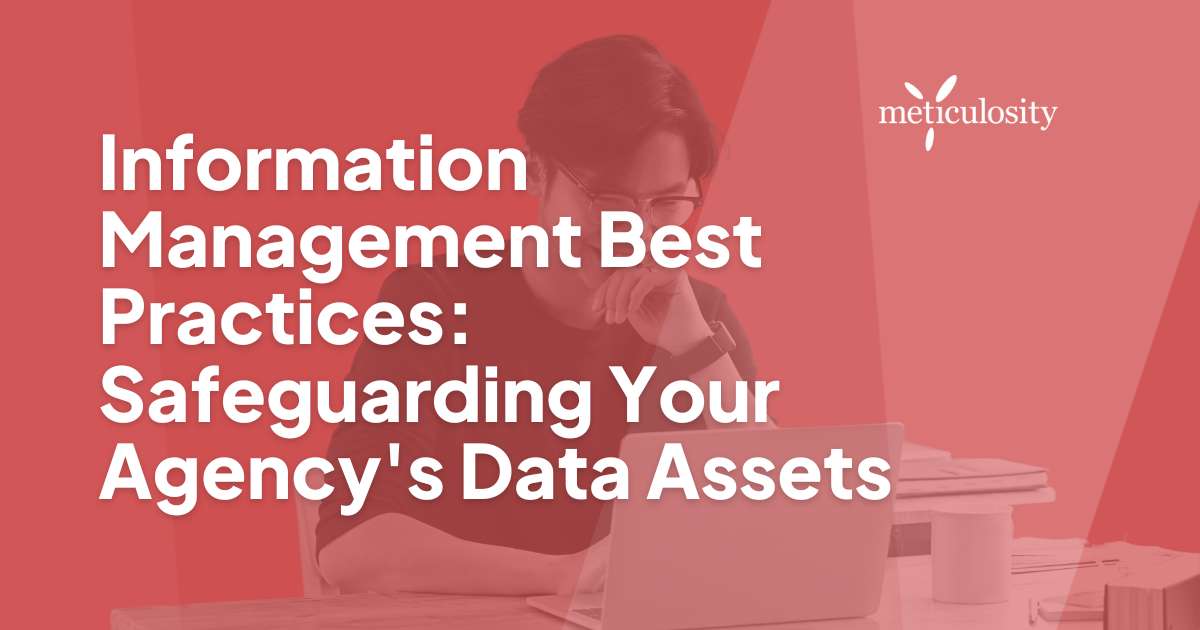Keeping your data safe is more than just a task; it can feel like you're the guardian of a digital treasure trove. Understanding that weight on your shoulders, consider this staggering fact: cyberattacks stripped businesses of over $2 trillion globally in 2019 alone.
Through this article, we'll share concrete strategies to bolster your agency's approach to information management and ensure your precious data assets remain under lock and key.
Looking to empower your agency? Learn how here.
Key Takeaways
- Understand the importance of complying with regulations and conducting security assessments to safeguard your agency's data assets.
- Focus on addressing the human factor in data security by providing regular training and promoting best practices within your team.
- Recognize the significance of creating a culture of data value within your agency, engaging stakeholders in data management, and implementing M-13-18 guidelines for robust data security.
- Implement strong encryption methods, manage inventory and data assets effectively, protect personal information, and adhere to federal data quality standards to ensure compliance and mitigate potential breaches.
Understanding Data Compliance
Understanding data compliance is crucial for safeguarding your agency's data assets. Conducting security assessments, addressing the human factor in data security, and utilizing encryption for sensitive data are all important aspects of maintaining compliance with privacy regulations.
Importance of complying with regulations
Complying with regulations keeps your agency safe from legal troubles and fines. It means you're doing things by the book, which is crucial for keeping trust with clients and the public.
Laws change often, so staying up to date helps avoid risks that can hurt your business big time. Plus, it shows everyone that you care about protecting their data.
Next, we'll dive into how conducting security assessments plays a major role in information management best practices.
Conducting security assessments
Following regulations is a big part of keeping data safe. Now, let's dive into how to make sure your systems and information are secure.
- Start with a plan. Every security check begins with a clear outline of what we need to do. This means deciding what parts of your system to look at and what kind of risks you're looking for.
- Gather a team. You'll want experts who know about cybersecurity to help you find risks in your systems.
- Use the right tools. There are many programs and software that can scan for problems in your systems.
- Look at everything. Make sure you check all parts of your network, not just the main areas.
- Write down what you find. Keep details on any weak spots or issues so you can fix them later.
- Test your defenses. Act like a hacker and try to get through your security to see how strong it is.
- Train your people well. Everyone should know how important it is to protect data and how they can help keep it safe.
- Make updates often. When you find problems, don't wait to fix them—update your systems right away.
Addressing the human factor in data security
Ensure your team knows their importance in keeping your data safe. Everyone who works with you gets training on best practices for data protection.
Also, remind your staff to use strong passwords and change them often.
Practice these security steps regularly so they become a habit. It’s like locking the front door at home – you do it without thinking because it keeps your house safe. That's how you treat information security around here; ensuring confidentiality is always top of mind.
Utilizing encryption for sensitive data
Utilizing encryption for sensitive data is crucial in safeguarding your agency's information. Encryption helps to convert data into a secret code that only authorized users can access, protecting it from unauthorized access or theft.
By implementing strong encryption methods and staying updated with the latest encryption technologies, you can ensure that your sensitive data remains secure from potential cyber threats and breaches, ultimately building trust with your clients and stakeholders while meeting compliance requirements for protecting personal information.
Records Management Best Practices
Identifying and utilizing data effectively, creating a culture of data value within the agency, and engaging stakeholders in data management are essential for safeguarding your agency's data assets.
Identifying and utilizing data effectively
In managing data, it's crucial to identify and utilize it effectively. By understanding the type of data we have, we can make informed decisions about how to use and protect it. This involves recognizing the value of different data types within our agency and ensuring stakeholders are involved in its management.
Engaging with the team helps create a culture where everyone sees the importance of using data effectively to drive better outcomes.
When we recognize the potential of our data and involve others in its management, we can harness its power to drive our agency forward. This means ensuring all team members understand how their work contributes to data value and are equipped with the tools they need for effective utilization.
Creating a culture of data value within the agency
To ensure that data is utilized effectively and efficiently within the agency, creating a culture of data value is crucial. This involves fostering an environment where everyone understands the importance of data in decision-making processes and daily operations.
By promoting a culture that values data, employees become more conscious about maintaining accuracy, security, and privacy in handling information. Engaging stakeholders at all levels of the organization is key as it encourages collaboration and commitment to upholding the integrity and significance of data assets.
Investing time and resources into educating employees on best practices for managing data can significantly contribute to establishing a culture where everyone recognizes the inherent value of accurate, secure, and well-maintained information.
Engaging stakeholders in data management
When engaging stakeholders in data management, it's important to communicate the value of their involvement. Here are some ways to do this:
- Clearly articulate the benefits of data management, such as improved decision-making and operational efficiency, to gain buy-in from stakeholders.
- Establish open communication channels to gather input and feedback on data management processes and ensure stakeholders feel heard and involved.
- Provide training and resources to help stakeholders understand their role in data management and how they can contribute to maintaining data integrity.
- Foster a culture of collaboration by encouraging cross-functional teams to work together on data initiatives, leveraging diverse perspectives for more comprehensive outcomes.
- Recognize and reward stakeholder participation in data management efforts to show appreciation for their contributions and incentivize continued engagement.
Data Security Best Practices
Managing inventory and data assets, protecting personal and sensitive information, and adhering to federal data quality standards are key to safeguarding your agency's data assets.
Managing inventory and data assets
By maintaining an inventory of your data assets, you can effectively monitor their usage, implement appropriate security measures, and streamline access controls. This proactive approach helps identify vulnerabilities and mitigate potential risks associated with sensitive information.
Marketers and business professionals need to recognize the value of their agency’s data assets. Establishing a comprehensive inventory management system enhances operational efficiency and plays a pivotal role in safeguarding against unauthorized access or loss of critical information.
Protecting personal and sensitive information
Protecting personal and sensitive information is crucial for maintaining data privacy and preventing identity theft. Implementing strong encryption methods, such as advanced encryption standards, helps safeguard sensitive data from unauthorized access.
It's important to adhere to federal data quality standards and proactive cybersecurity measures to protect personal information effectively. This includes monitoring IT security infrastructure and managing insider threats, ensuring a robust defense against potential risks.
Mitigating the risk of privacy breaches requires constant vigilance in identifying and addressing vulnerabilities promptly. By adopting these best practices, businesses can ensure that personal and sensitive information remains secure while complying with regulations.

Mitigating Common Data Security Threats
Educating employees on phishing attacks, utilizing antivirus software, and managing insider threats are crucial in protecting your agency's data.
Educating employees on phishing attacks
To protect our agency's data assets, educating employees on phishing attacks is crucial. These attacks often come in the form of deceptive emails or websites that trick people into revealing sensitive information like login credentials or financial details.
By training staff to recognize and report suspicious emails, we can significantly reduce the risk of a successful phishing attack. It's essential to emphasize the importance of verifying the authenticity of requests for sensitive information and encourage everyone to stay vigilant against these common data security threats.
As part of our efforts to safeguard our agency's data assets, educating employees on phishing attacks plays a vital role. Phishing attacks can lead to unauthorized access to personal and sensitive information, making it crucial for all staff members to be aware of the signs of such attempts.
Utilizing antivirus software to prevent malware and ransomware
Educating employees on phishing attacks is crucial, but utilizing antivirus software for a comprehensive defense against malware and ransomware is vital. Antivirus software protects your agency's data assets, identifying and neutralizing potential threats before they can wreak havoc.
Regularly updating and running antivirus scans across all devices and networks establishes a robust barrier that deters malicious entities from infiltrating your systems.
Moreover, incorporating reliable antivirus software aligns with risk management best practices, bolstering your overall data security framework. It helps safeguard personal information while actively preventing identity theft – essential aspects of privacy management within information technology.
Managing insider threats
To manage insider threats, educating employees about the risks and consequences of unauthorized data access is essential. Implementing a clear and strict access control policy can limit employees' ability to manipulate or misuse sensitive information.
Regularly monitoring employee activities and behavior patterns can also help detect any suspicious actions that may indicate an insider threat. By fostering a culture of transparency and accountability within the organization, it's possible to mitigate the risk of insider threats effectively while promoting a secure data environment for your agency.
By creating awareness among employees about potential security breaches, agencies can significantly reduce the risk of insider threats. Monitoring user activity closely is crucial in identifying any abnormal behaviors or unauthorized attempts to access sensitive data.
Establishing a Data Governance Framework
Developing policies and procedures to effectively manage, protect, and utilize data within the agency.
Developing policies and procedures
Developing policies and procedures is crucial to properly managing agency data assets. It involves:
- Defining clear guidelines for handling and protecting sensitive information, such as personal data and business secrets.
- Creating a structured framework outlining the roles and responsibilities of employees in upholding data security standards.
- Establishing protocols for regularly reviewing and updating policies to align with evolving data protection regulations.
- Implementing training programs to educate staff on the importance of adhering to established policies and procedures.
- Enforcing strict measures for reporting any potential data breaches or security incidents promptly.
Establishing data ownership
Establishing data ownership is crucial for ensuring accountability and clarity within an agency's information management practices. Clearly defining who owns the data makes it easier to determine responsibility for its accuracy, security, and appropriate usage.
This ownership framework helps create a culture of respect for data integrity and can aid in efficient decision-making processes.
Engaging stakeholders in discussions about data ownership ensures that everyone understands their roles and responsibilities. This fosters a collaborative environment focused on safeguarding the agency’s valuable data assets.
Ensuring data integrity
After establishing data ownership, the next step is ensuring data integrity. This involves maintaining the accuracy and consistency of your agency's data throughout its lifecycle. You can prevent unauthorized access, tampering, or data corruption by implementing proper controls and validation processes.
Utilizing encryption and access controls helps in safeguarding the integrity of your agency's valuable data assets.
To maintain a high level of data integrity, regular monitoring and audits are essential to identify any anomalies or discrepancies that may compromise the accuracy and reliability of the information.
Implementing Data Classification
Identifying sensitive data
Identifying sensitive data within our agency is crucial for maintaining security and compliance. By recognizing personal information, financial records, and any other data that could pose a risk if exposed, we can take targeted measures to safeguard it effectively.
It's essential to consider the type of data, where it's stored, and how it's being used or shared. This proactive approach allows us to prioritize protection efforts based on the sensitivity associated with different data types, ultimately strengthening our overall data security posture and minimizing the potential for identity theft or unauthorized access.
As we identify sensitive data throughout our agency, we must remain vigilant in applying appropriate security measures to protect this information from unauthorized access or misuse.
Applying appropriate security measures
When it comes to safeguarding your agency's data assets, applying appropriate security measures is crucial. Here are some key practices to consider:
- Regularly update and patch all software and systems to mitigate vulnerabilities.
- Utilize strong authentication methods, such as multi-factor authentication, to protect access to sensitive data.
- Implement network segmentation to restrict unauthorized access within the organization's infrastructure.
- Enforce strict password policies, including regular password changes and complex passwords.
- Employ robust firewall solutions to monitor and control incoming and outgoing network traffic.
- Train and educate employees on best security practices, including recognizing and reporting potential security threats.
- Utilize encryption for data both at rest and in transit to ensure data remains secure from unauthorized access.
- Conduct frequent security assessments and audits to identify potential weaknesses in the system.
Conducting Regular Security Audits
Regular security audits are essential for identifying and addressing vulnerabilities in your agency's data assets. Stay ahead of potential threats and ensure compliance with regulations by conducting regular security audits.
Identifying and addressing vulnerabilities
Identifying vulnerabilities in your data security is crucial to safeguarding your agency's valuable assets. Regular security audits help you pinpoint weak spots and potential threats, allowing for proactive measures to be taken.
By staying vigilant and addressing vulnerabilities promptly, you can ensure that your data remains secure and protected from unauthorized access or breaches.
Furthermore, by conducting thorough security audits, you can also demonstrate compliance with relevant regulations and standards. This establishes trust with your stakeholders and minimizes the risk of legal repercussions due to non-compliance.

Conclusion
In conclusion, safeguarding your agency's data assets is critical for compliance and security. You can protect sensitive information from breaches by implementing best practices in information management, such as conducting regular security audits and educating employees on common data threats.
Establishing a robust data governance framework and utilizing encryption is essential to mitigate risks effectively. Remember, prioritizing data security safeguards your agency's reputation and fosters trust with stakeholders and clients.
Click here to learn more about agency marketing.
FAQs
1. Why is information management crucial for marketing agencies, and how does it impact overall operations?
-
- Data Integrity: Information management ensures the accuracy and reliability of data, a cornerstone for making informed business decisions.
- Compliance and Trust: Proper information management practices help agencies comply with data protection regulations, fostering trust with clients and partners.
- Operational Efficiency: Well-managed information facilitates seamless internal processes, promoting efficiency in day-to-day operations.
2. What are the key best practices for safeguarding data assets within a marketing agency?
-
- Access Controls: Implement strict access controls, granting data access only to authorized personnel based on their roles and responsibilities.
- Regular Backups: Perform regular data backups to prevent data loss due to unforeseen circumstances, ensuring business continuity.
- Encryption: Utilize encryption techniques in transit and at rest to protect sensitive data from unauthorized access.
- Employee Training: Conduct regular training sessions on data security protocols and the importance of responsibly handling information.
3. How can marketing agencies effectively balance the need for data accessibility with the requirement for data security?
-
- Role-Based Access: Adopt role-based access controls, ensuring employees can access only the data necessary for their specific roles.
- Audit Trails: Implement audit trails to monitor data access and changes, providing transparency while maintaining security.
- Encryption Solutions: Use encryption solutions that balance data accessibility for authorized users while safeguarding information from unauthorized access.
4. What role does compliance play in information management for marketing agencies, and how can they ensure adherence to data protection regulations?
-
- Legal Obligations: Compliance ensures that agencies meet legal obligations related to data protection, avoiding potential legal issues and penalties.
- Client Trust: Adhering to data protection regulations builds client trust, demonstrating a commitment to safeguarding sensitive information.
- Data Governance Policies: Develop and enforce comprehensive data governance policies that align with applicable regulations, providing a framework for compliance.
Information management best practices are integral to the success and reputation of marketing agencies, promoting data integrity, operational efficiency, and adherence to legal and ethical standards.







